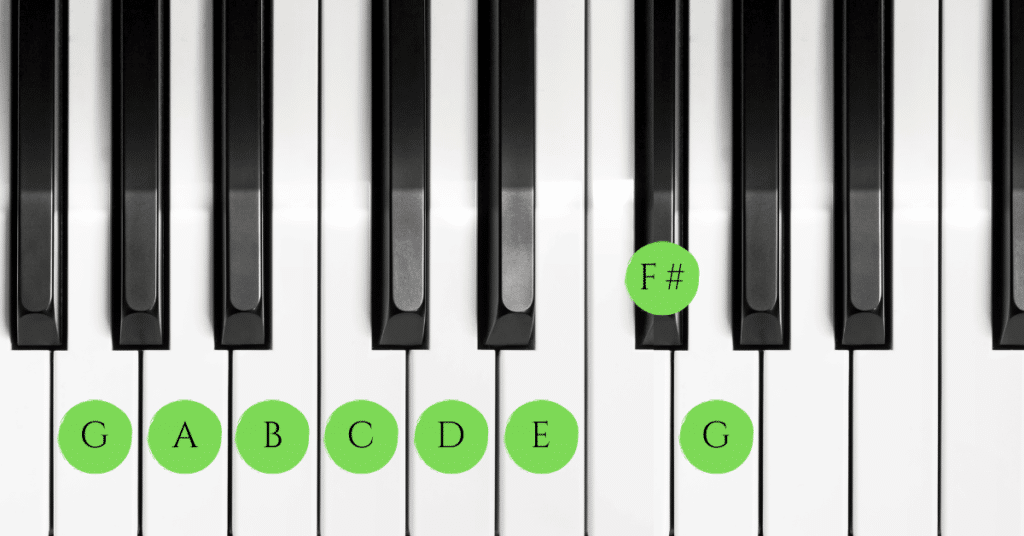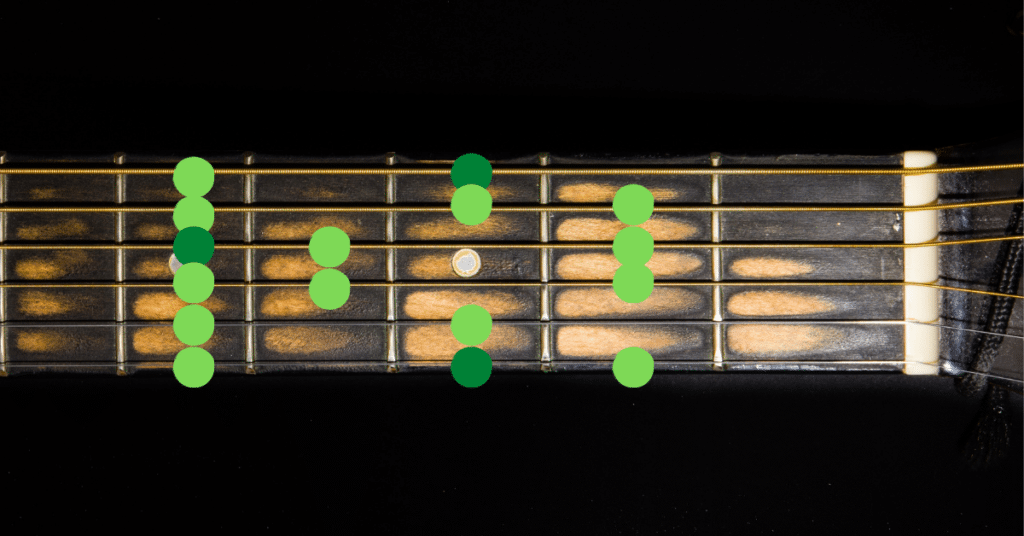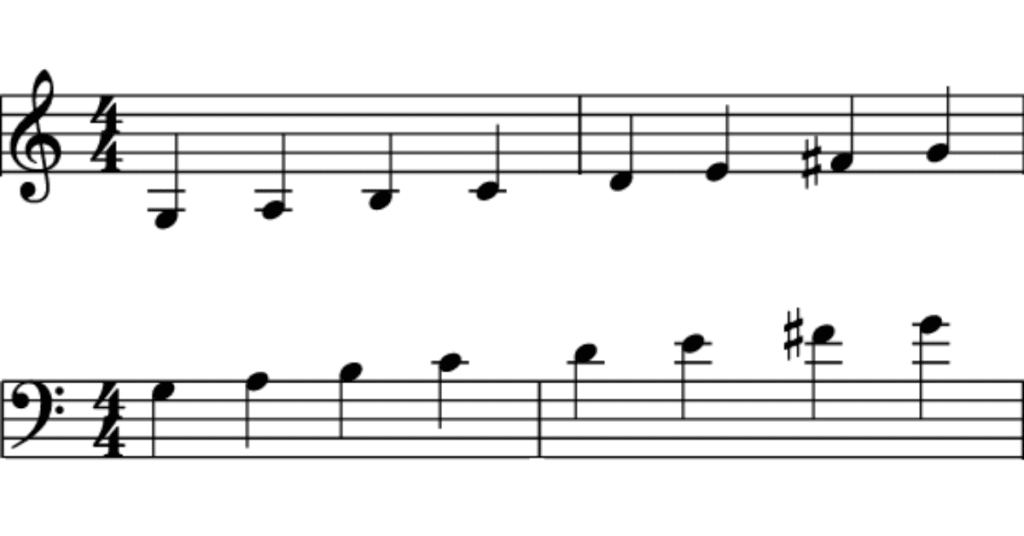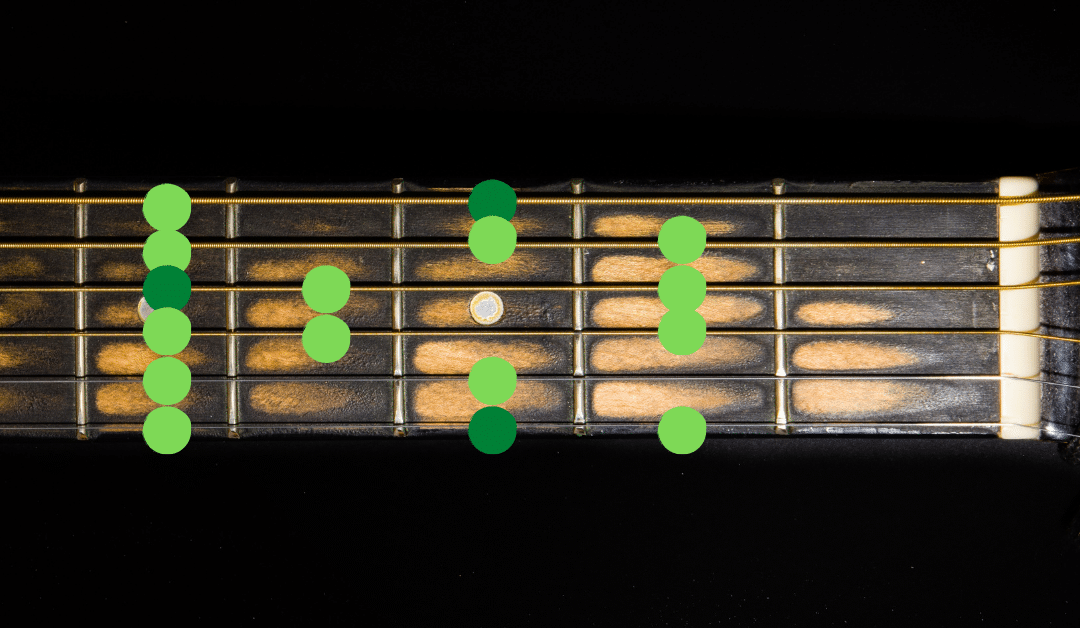The G major scale is a good start for those who are beginning their musical studies and want to learn to play an instrument like the guitar. Unlike other scales, it is very practical since its execution does not require much skill and its sonority is very well known. It is one of the most used scales in classical and popular music, and represents one of the best tools to experiment with melodies and harmonies, taking the first steps into the world of composition.
What is the G Major Scale?
The G major scale is a scale of musical notes that are structured in intervals of one tone between each degree, with the exception of degrees III – IV and VII – I, where the distance is half a tone, and whose main note (commonly called tonic) is G. That is, the G major scale is built starting from the note G and continues leaving a tone between each note, except between the third and the fourth and between the seventh and the first note.
In this way, we can say that the notes that make up the G major scale are:
- I – G (G) : tonic
- II – The (A) : supertonic
- III – If (B) : by means of
- IV – C (C) : Subdominant
- V – D (D) : Dominant
- VI – E (E) : Superdominant
- VII – F sharp (F#) : Sensitive or subtonic
Thus, it is the tonic G which, being the first note of the scale, gives the scale its name.
G major scale patterns
One of the best options for learning the scale is to visualize it on instruments such as the guitar or the piano. These instruments have a visual character that helps to identify more easily the notes and the distances between them. So, see what the G major scale pattern would look like in an octave on the piano:

Note that the scale can be found on the white keys except for only one of its notes, the F sharp. This makes the G major scale learnable for beginner musicians, avoiding the hassle of having to identify complex patterns when playing it. On the other hand, the guitar fulfills the same function with the various patterns that can be found on the neck. In the following image you can see one of these patterns:

Thus, based on these forms we could create several melodic phrases along with both instruments. In the case of the piano, the pattern is the same in all octaves. However, on the guitar, the patterns vary along the neck. To find them you could identify all the notes belonging to the scale on each string and then play over all of them.
The G major scale and other instruments
Due to the small number of accidentals (sharps and flats) that the scale has, it is usually taken as a starting point for the study of many instruments. It is ideal for stringed instruments such as guitar, violin, viola, cello, double bass, mandolin and many others. These instruments are tuned in such a way that by playing their strings in the air we can naturally obtain different notes of the G major scale. For example, the viola is tuned to the notes C, G, D, and A, while the mandolin is tuned to the notes G, D, A, and E, all belonging to the G major scale.
Harmonizing the G major scale
Another important feature of this scale is its harmonization. This process consists of building chords on each of its notes based on the accidentals that the scale has (see harmonizing major scales). Thus, when harmonizing the G major scale, taking into account that it has only one alteration (F sharp), the following chords are obtained:
| Grade | Chord Name | Chord Formula |
| I | G major | G |
| II | The minor | Am |
| III | B minor | Bm |
| IV | C major | C |
| V | D major | D |
| VI | E minor | Em |
| VII | F sharp semi-diminished | F#Ø |
In this way, we could take a series of chords from the ones shown in the table and play them one after the other. This would be playing a chord progression in the key of G major, being the first chord (G) the one that gives the key its name.
Importance of this harmonization
Harmonizing this scale not only introduces new combinations of its notes but also expands the possibilities of composition and melodic and harmonic improvisation in the key of G major. Chords can be combined in many ways and result in various expressive forms. Everything is at the musician’s hand so that he can join the concepts of melody, harmony, and rhythm-based on the feelings and ideas he wants to express.
The following chord progressions can be used as a basis for building harmonies in G major.
G major chord progressions
- G – C – D – G
- G – Em – C – D – G
- G – Am – C – D – C – G
- G – Em – Am – D – G
- G – D – Am – C – D – G
These progressions can be played one after the other at a tempo appropriate to the skill of the player. In turn, they can be accompanied by melodic phrases using the notes of the G major scale, perhaps adding external notes to the scale in order to enrich the piece.
Musical notation of the scale
On the other hand, the representation of the scale with the help of traditional musical notation reinforces the learning of the scale, since it illustrates in detail the notes and the intervallic distances between each one of them. The G major scale can be written in either the key of G or the key of F as follows:

Knowing the musical notation of the scale gives the musician an advantage when performing songs written in the same key. Whenever we find a song written in a pentagrammed notebook, the first thing to do is to identify the key of the song. To know if a song is in the key of G major, we must make sure that the only alteration in the key signature of the score is an F sharp. Knowing this, we already know that all the notes of the song, except for some possible chromaticisms, must be notes belonging to the G major scale and, therefore, must fall in the patterns of this scale.
Harmonized scale notation
The harmonized scale is not usually represented in traditional musical writing. Instead, it is usually represented with the American notation, such as C, D, Em, etc. However, in the study of music theory it is usually very useful because it helps to visualize the notes that make up each chord and, if desired, allows us to add modifications to them, directly altering the desired notes.
G major and minor scales
It is common to think that the G major and G minor scales represent the same thing. But, in fact, they have no properties in common that would make them sound or function the same.
The G major scale has a structure where the third and fourth notes are separated by a half-tone, the minor scale has a structure where the third and fourth notes are separated by a tone (see minor scales). This difference, coupled with additional properties characteristic of the minor scale, produces very different scales. At the same time, taking into account that they do not have the same notes, it is right to think that the chords obtained from the harmonization of both will also be different. Therefore, we can expect a song written in the key of G major to have a very different sonic character than a song written in the key of G minor.
Intervallic distances in the G major scale
To better understand how the G major scale works, it is useful to analyze the intervallic distances between each of its notes:
| G | – | A | – | B | – | C | – | D | – | E | – | F# | – | G |
| – | 1T | – | 1T | – | 1/2T | – | 1T | – | 1T | – | 1T | – | 1/2T | – |
So, altering any of these distances would compromise the nature of the scale, and with it its sonority.
Relative scale of G major
Although the G major and G minor scales are not the same, we can find a scale that shares the same notes with the G major scale. This scale is commonly called the ‘relative scale’ and is, in fact, a minor scale. Thus, having the same notes, it also has the same chords.
This does not mean that they are one and the same scale, as both scales are used for different purposes. The relative scale of G major is the scale of E minor (Em), and its notes and chords can be written, in traditional notation, with the use of the same G major key signature (see
relative scales
).
Now, if we want to compose or improvise in the key of E minor we can use the chords and scale of G major. But it is important to keep in mind that the use of chords will not be the same in both keys. For example, a song in G major would commonly use chords such as G, C and D, while a song written in E minor would usually employ the chords Em, Bm and Am. Similarly, the success of the final result lies in the knowledge and creativity that the person puts into practice.
How do we know if we play in G major or E minor?
If when playing a song we find chords belonging to the harmonization of G major, we could ask ourselves which key we are in, G major or E minor. It is certainly not an answer that we can always get at first sight since many factors related to the harmony and melody of the piece in question influence it. However, we can make some guesses based on the chords on which the song rests, both at the end of its sections and at the beginning. For example, if the song concludes its sections with major chords, especially with the G major chord, we could consider that the key is major. Otherwise, if the final chords are minor, the key could be thought of as minor. In any case, it is not a simple task, and only study and practice can help the musician to solve it.
Songs written in G major
The G major scale has been used for a long time in many different musical styles. Since the baroque period music has passed through the hands of classical composers such as Johann Sebastian Bach and Joseph Haynd for the composition of studies and sonatas. On the other hand, this scale has also been widely used in rock, indie folk and blues. Among so many compositions made with the use of the G major scale, the following can be taken as a reference:
- Blackbird, by The Beatles.
- Sweet Home Alabama, by Lynyrd Skynyrd.
- Nothing Else Matters by Metallica.
- Wish You Were Here, by Pink Floyd.
- Little Wing, by Jimi Hendrix.
- Gravity, by John Mayer.
Some of these songs may not rest their verses or choruses in the key of G major, but in the key of E minor. However, they can be taken as a basis for the study of composition in both tonalities.
Conclusion
The G major scale is one of the easiest scales to learn due to its theoretical simplicity. As it has only one alteration (F sharp) it allows to interpret and translate the musical language with greater comfort, accelerating the skill of the musician at the moment of executing it in the instrument. It represents one of the first steps that every musician should take in the study of scales and, with the help of its harmonization, one of the first steps that every musician should take in the world of composition.
Tips
- Study the rest of the G major scale patterns on the neck of the guitar and compare the position of the tonic in each of them.
- Form more complex chord progressions with the chords obtained in G major harmonization.
- Find songs written in the key of G major or E minor and improvise short phrases on them.
- Write the chords in the key of G major in a pentagrammed notebook and add the sevenths to each of them.

